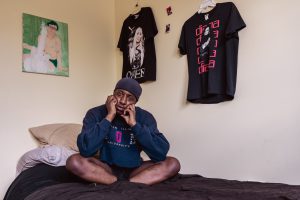[Content Warning: rape and sexual assault]
_
_
_
_
_
_
Author’s Note: This article makes brief mention of Roger Bonair-Agard, a nationally recognized poet and a former program director and teaching artist at Free Write Arts & Literacy. Since 2013, several people involved in poetry organizations that employed Bonair-Agard have come forward to say that Bonair-Agard manipulated his position of power, sexually assaulted, or raped them. In October 2020, Bonair-Agard was fired from Free Write due to, in Free Write’s words, being a “known abuser” and for publishing a poem in 2014 that details a rape he committed. I did not interact with Bonair-Agard during my writing residency with Free Write, and he is not the focus of the writing below. But with such a long history of institutional silence and whisper networks, I believe it important that this reality not be suppressed. I owe immense gratitude to Fatimah Asghar, Itunu Ebijimi, and Plus Sign for publicly addressing Bonair-Agard’s sexual violence and the failings of institutions that employed him, and I am including this note in solidarity with them and with survivors of sexual violence. You can read Fatimah Asghar’s statement here; watch Itunu Ebijimi’s here; read Plus Sign’s here. Nothing has been altered or redacted from the article below.
* * * *
This project asked us to envision justice. It offered the arts as a lens. As I first began to wrap my mind around the Envisioning Justice initiative (“Bringing Chicago together to examine and reimagine the criminal justice system through a creative lens”), I entered a rabbit hole of unanswerable and annoyingly abstract questions, like, what is art? (Beauty? Truth? Life? Fantasy?) And, what is art for? (Self-expression? Transcendence? Joy? Education? Justice?) Can it really be for justice? And then, of course, what is justice? How does something as wishy-washy and abstract as art bear on something as heavy and real as incarceration?
In the two articles I published previously for the Envisioning Justice writing residency, I included responses to the prompt, “How do you envision justice?” from two artists who have been working within Illinois jails and prisons for years. Both responses were not cynical, but rather the opposite; they were tired of the question. It’s the work, not the envisioning of the work, that needs to get done, they seemed to say.
Here’s Sarah Ross, who is part of the Prison + Neighborhood Arts Project and a teaching artist at the Stateville Maximum Security Prison. Ross participated in a panel discussion at the Art Institute of Chicago that kicked off the Envisioning Justice initiative in April 2018, (joined by the Cook County Board President, the State’s Attorney, a Chief Judge, and a Chief Investment Strategist). When asked by the moderator how she might imagine a redesign of the system, Ross said, “I actually think we know what we need to do to change the system, but we don’t have the political will yet to do it.”
And, here’s Ryan Keesling, who, as co-founder of Free Write Arts & Literacy, has been teaching young people in the Cook County Juvenile Temporary Detention Center for over 18 years: “I don’t know, I think people try too hard to think about what [justice] will look like…I can imagine it, but also when I imagine it I don’t necessarily feel it. But when I see their faces and when I work with our students, both inside and outside, and I see them growing and I see them becoming aware of their abilities, and I see them being able to take control of their lives and I see them being happy and getting paid and doing what they love? That’s what justice looks like.”
These responses struck me because in a matter of words, both Ross and Keesling betrayed the prison system, with its reliance on seeming permanence and unquestionable righteousness, and bypassed any hand-wringing about how reform or abolition is difficult or impossible to think with. (Angela Davis in Are Prisons Obsolete?: “People take prisons for granted.”) Both Ross and Keesling said, no, this is not righteous or justice, nor is it permanent. And, Ross said, we know that.
* * *
For 18 years, Free Write Arts and Literacy has been teaching within the Cook County Juvenile Temporary Detention Center (CCJTDC). What started as one-on-one tutoring sessions grew into a robust curriculum based on an expanded notion of “literacy” that includes, in addition to poetry and prose, DJing, painting, digital illustration, music production, and other mediums for making sense of and communicating with the world. More recently, Free Write has expanded its reach in order to support its students in areas beyond the CCJTDC classroom.
The expansion is less of a forward bound than a natural extension of the principles and practices grounded in their pedagogy. Free Write’s mission is to provide its students with the tools and mentorship to author the narrative of their life experiences and to create space for liberation and redemption within (and without) the walls of the prison-industrial complex. They have a student-centered approach that allows for the students’ desires and goals to guide the curriculum. Free Write’s extracurricular projects tend to evolve as responses to requests from students and through ongoing conversations with them.
Take, for example, their recent efforts to develop a system to consolidate students’ work and learning in the classroom such that it could stand as mitigating evidence in their court proceedings. This resonates with current national movements for restorative justice and more active community involvement in legal defense, such as the Participatory Defense movement (its most public advocate, Raj Jayadev, was named a MacArthur Fellow last year). For Free Write, this started as a simple practice of responding to requests by current and former students for materials from the portfolios they developed in the classroom—simple in spirit, not in its execution. Free Write staff would take time to curate a selection of work, make the necessary scans and screen shots, and put together a file that students could bring to their attorney or judge.
Each week, Free Write works with nearly 65 of the, on average, 225 youth in pre-trial detention at CCJTDC. In the classroom, Free Write staff and students collaborate on an “asset map”: a double-sided, single sheet that prompts students to list their skills, hobbies, interests, participation in programs, and work experience and asks questions about their short and long term goals, their challenges, and their support systems. (More on this later).
Three years ago Free Write established a production company, Free Write Sound & Vision, that trains and employs former students as audio technicians for live concerts and events. Sound & Vision typically partners with arts organizations and production companies with aligned missions, so the events for which its team is hired to provide equipment and technical support serve both as an employment opportunity and another site of community with other artist-activists in Chicago. Over the summer, the Sound & Vision team set up sound systems at festivals like AMFM’s Feast and the Loop Alliance’s Activate series. In September, they participated in 96 Acres Project’s Radioactive event that broadcasts stories written by current and former inmates at Cook County Jail on Lumpen Radio.
Sound & Vision, too, as Ryan described, came about in response to alumni who reached out to Free Write staff looking to reconnect upon coming home.
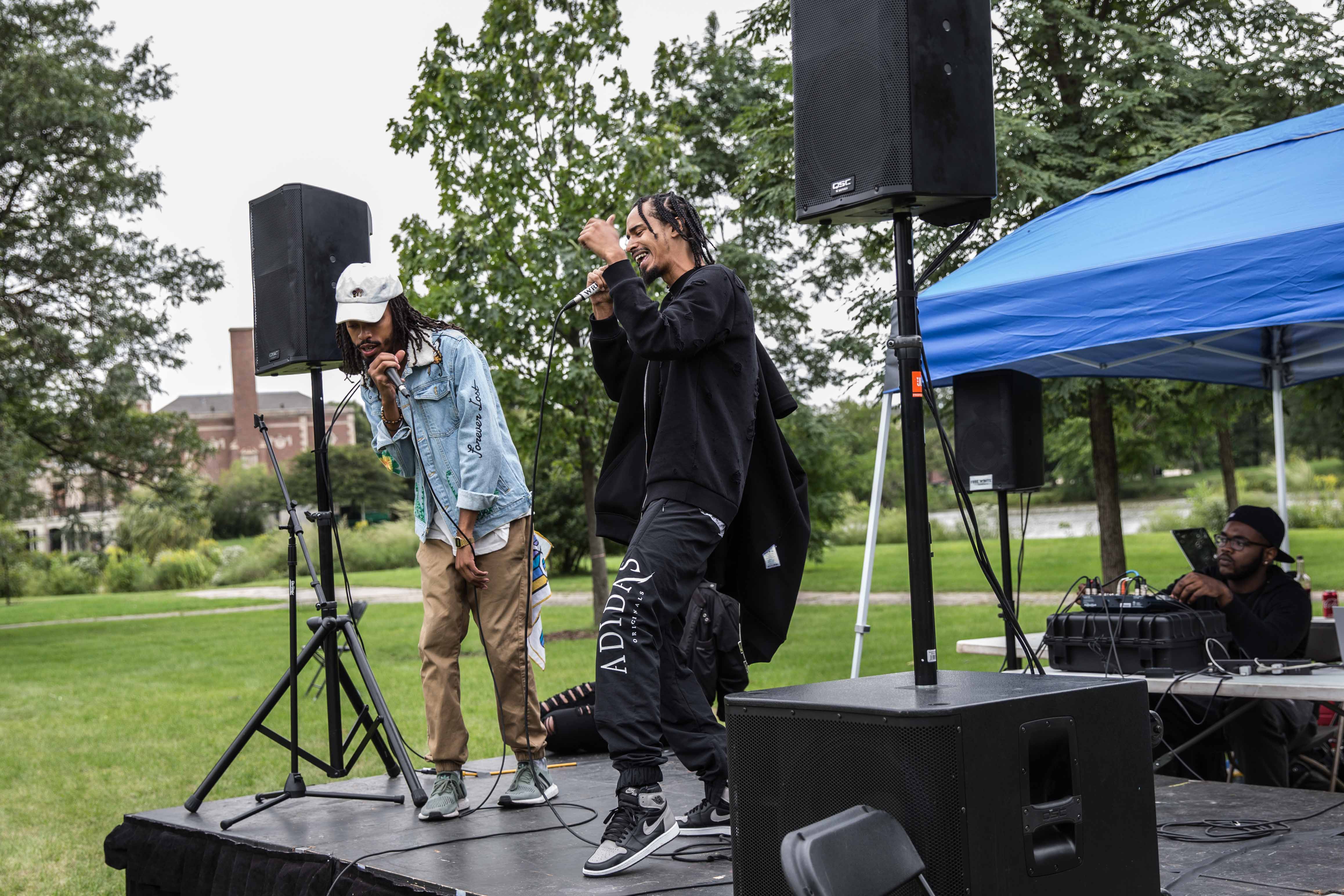
I: Sound & Vision
One of those alumni, Cortez Williams, just turned 20 this month. He is a DJ from the West Side, a former football player, and an alumnus of Free Write’s program from when he was detained at CCJTDC. Cortez learned how to DJ while he was in CCJTDC. “That,” he told me, “was my outlet. When you locked up, I mean, you can’t really do nothing.”
I asked him why he was drawn to DJing over the other art forms that Free Write offers. “I felt like that was my only way of knowing what was going on on the outside,” he continued. “All I could do was listen to the radio and be like, ‘Oh, okay, they got this new song out, I know they got them listening to this new song.’ And hearing the old music I haven’t heard in a long time that’s decent. It low-key will relax you, like, I’d just be singing. I would catch myself later on in the day just rapping the song that I was just mixing. It just kept me calm and I had something to look forward to. I was just ready to go to DJ class. It’s fun, you feel me, and they was telling me you can get paid big money for it, but I wasn’t thinking I was going to get paid big money for it. So when Free Write actually offered me the job, I was real happy. I took the job right away.”
In addition to working with Sound & Vision, Cortez has traveled around the country with Free Write to participate in conferences and events related to youth incarceration. In Michigan, Cortez taught a five-day DJ workshop to fifth graders. He was surprised, he told me, when, at the end of the workshop, the students wrote him a card saying they were going to miss him. I asked him how he understood why they said that.
“I think because I gave them some leeway,” he answered. “Everyone else was talking down to them like they fifth graders, because I mean, they fifth graders and they bad, but when they got to me, I was like, ‘Look, you do this right five times straight, I’ll let you listen to whatever song you want to listen to on YouTube, uncensored.’ So they did it. Everybody got to doing it right. They did what they was supposed to do, and I let them listen to their songs.”
Cortez is no stranger to being talked down to by adults. Even at conferences that allege to center the youth, he told me, it’s all too common for the adults to dominate the conversation. At a conference about youth incarceration in New York, Cortez recalled sitting back with his arms folded as he watched the adults in the room talk over all the young people who are, in fact, the experts on youth incarceration. I asked him what he had wanted to say that the adults didn’t want to hear.
“Money should be being dispersed,” he replied. “They just holding it until they think they found out what to do. I mean, that’s not doing anything. There’s a lot of organizations that go inside the facilities and actually try to help with what’s going on in the facilities. They’re volunteering their time around the country. Why are we still waiting? If they going inside the facility and they need, like, electronics for the kids inside, okay, get them the money they need for electronics.”
Where does he think the money should go?
“Mentors. These judges and these police officers don’t know what it’s like to wake up, go in the kitchen, go in the refrigerator, and ain’t no food in there. In a child’s home. They don’t know what it’s like. I feel like having mentors, like, people who are in the life of the youth– if you get [young people] comfortable enough to share the fact that they don’t have anything in their refrigerator, then, okay, their mentors could go buy some food. So the youth ain’t gotta do nothing stupid to try to get some food.
“What Free Write does is, like, if you can’t get on the CTA bus because you are gang-affiliated and you have to pass your rival enemy’s territory on the bus, Free Write will get you a Uber or a ride. They finna pay my phone bill because my phone was off for a minute, because I was having problems with my mom, so they offered, like, ‘Can we pay your phone bill?’ That’s love. Just having people showing they care. When you young and you get arrested you feel like nobody cares. So when someone actually show you they care, you feel me, they real-life trying to help you, you’re going to try. At least try.”
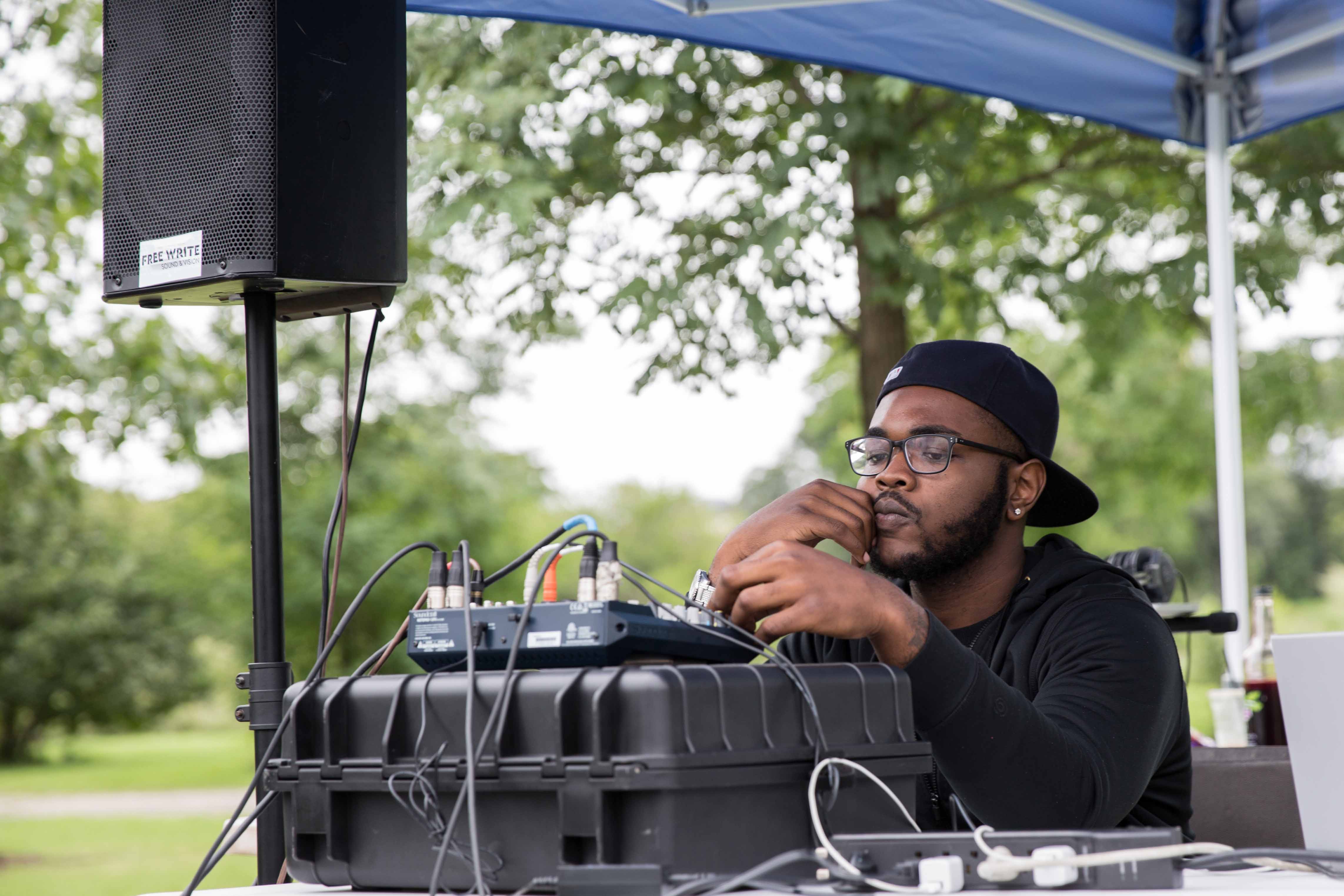
In addition to working with Free Write Sound & Vision, Cortez has a job selling pizzas at O’Hare. When we met up in December, he told me he had been working overtime at O’Hare to make a good impression so that he would have some sway when he referred his older brother to the job. After we left the cafe where we’d snacked on cinnamon buns and chips and guac, Cortez walked me to my bus stop. As we passed the new Steak ‘n Shake on Halsted Ave., he decided that he would swing back to pick up something for his grandma, who favors their burger, and who he was going to pay a visit once we parted.
In March 2017, Cortez was visiting his grandma when something nearly miraculous happened. “It was an act of God,” he said. Cortez had just been released from three months of electronic monitoring—house arrest. He had gone to see his grandma with his mom. On their way back, his mom’s car broke down. They hailed an Uber, a pool. After a few minutes in the car, their fellow passenger spoke. “Cortez…?” It was Roger Bonair-Agard, a program director and teaching artist with Free Write. “Oh, Roger, what’s up?” As they caught up, Roger asked Cortez if he could pass his contact information around the organization, before inviting him over for a meal. Shortly after, Cortez was DJing at the regular open mic event produced by Free Write, Stomping Grounds. Then Ryan told him about his idea for a production company that would teach young people how to set up and operate sound systems for events. Now, as a lead technician for Sound & Vision, Cortez is paid $25/hour.
“I’m not gonna to leave Free Write, period,” Cortez said. “Free Write kind of saved my life. When I came home [from CCJTDC] I didn’t know what I was going to do. I could’ve went back to doing the things that I did to get me arrested, but Free Write gave me that job that was paying me [at the time] $20 an hour. I don’t have to do what I used to do.”
For many DJs and artists, audio technician work provides a valued source of income in a related field. But it is an industry where straight white men are overwhelmingly over-represented and, when gigs are often passed through personal networks, it can be difficult to thrive for those who don’t fit into the culture. Ryan, himself a veteran DJ and audio technician, began to conceive of a Free Write production company as a way to use his expertise and industry contacts to help bring people with different backgrounds into the field. After Cortez came home and got back in contact with Free Write, the concept for Sound & Vision began to gel.
The training that Sound & Vision offers is not limited to technical skills. It’s a small team, so the technicians are also expected to coordinate the logistics with event producers and plan their own events. They attend regular meetings to discuss the direction and mission of Sound & Vision. They are encouraged to pursue their interests through the company. At one meeting I attended, one technician brought up her interest in organizing a workshop and networking event for DJs. Everyone discussed the equipment it would require, whether the event should have a delineated agenda or be more casual, if DJs are more likely to attend on weekdays or weekends, and the feasibility of securing snack donations. It was added to the calendar that day.
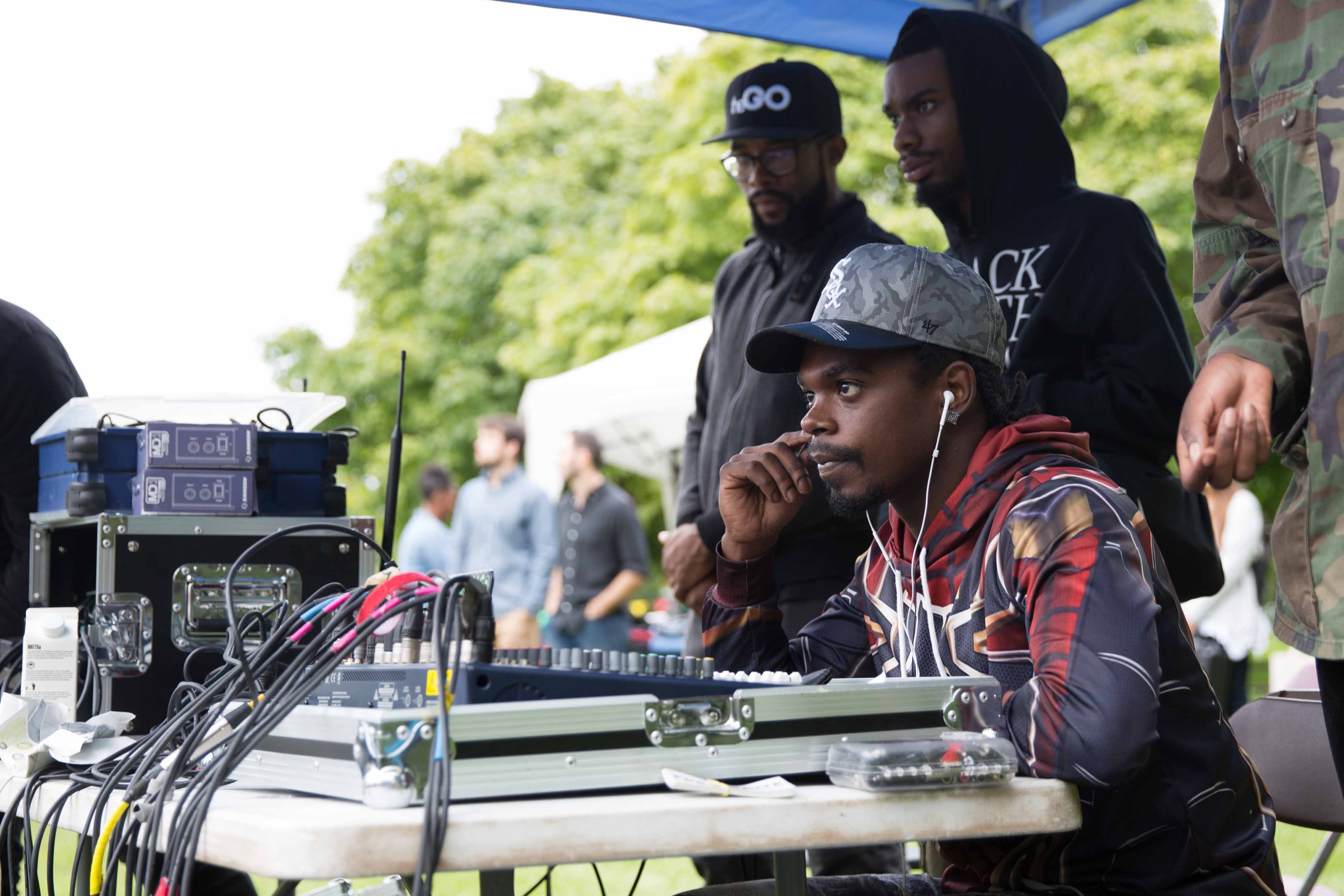
II: Mitigation
Cortez and his grandma were at the polls last November when Cortez noticed something. “Grandma! Look, it’s that judge. Vote no!” It was Matthew E. Coghlan, who, due to a rigorous campaign by several prison reform and watchdog groups that compiled information indicating his racial bias, excessive sentencing, and alleged role in framing two men for murder, was the first Cook County judge voted off the bench in 28 years. It was Coghlan, too, who had tried to send Cortez to jail for 15 years when he was 15.
I asked Cortez if that moment had felt like an instance of justice. He furrowed his brows and shook his head. “No.” How does he envision justice?
“Equality,” he replied. “You can’t have justice until you have equality. There’s always going to be some kind of injustice. Judges are humans, too. So as long as there’s going to be someone judging you on your life based on your actions, there’s going to be justice, but not real justice. You know what I mean? I don’t feel like justice is going to be served until you actually look at both sides of the story…Honestly, I feel like if people take the time, if adult judges take the time to hear the other side of the story, they might look at the bad side of the story like, ‘Man, if I was in his situation, if I can see my daughter’s ribs and she’s not eating, then I would rob somebody.’ The judges, they don’t know nothing about that.”
* * *
Chicago is home to the world’s first juvenile court. The court was established in 1899 in the midst of a social welfare movement led mainly by middle class progressive women such as Jane Addams and Julia Lathrop and their peers at the Hull House. Until then, children as young as seven could be charged and sentenced as (and jailed with) adults. The early reformers built their case for a separate juvenile system on the basis that criminal behavior was a symptom of poverty and derelict public service and that “delinquent” children need protection, not punishment. (The term “delinquent” was introduced in this era to distance juveniles from criminality).
A distinguishing factor of the new juvenile court was the expansion of the judge’s discretionary power. The judge’s task in this new court was to assess an adolescent’s individual needs and determine an appropriate plan for rehabilitation, rather than administer punishment for a crime.
The establishment of the court was soon followed by a juvenile detention home and a burgeoning industry centered around juvenile justice and child welfare. Over the next several decades, the emergence of new professions such as probation officers, social workers, and psychopathologists reflected more holistic, rehabilitation-minded theories of criminality, child development, and economic inequality. A 1934 report by the Illinois Institute for Juvenile Research offered a delinquency prevention plan that recommended more recreation programs for youth.
However, through the 1930s, the social welfare ideology of the early juvenile court system began to lose favor. In the midst of rising racial tensions and violence, the courts became more punitive yet again, and judges regained the power to prosecute children over ten as adults. In 1965, Illinois rewrote the juvenile justice act. This act introduced public defenders, thus restructuring the court to be more adversarial than deliberative. In the 1970s and 80s, as the “War on Drugs” infiltrated criminal justice systems countrywide, sentencing became even harsher, and by 1994 the Cook County Juvenile Detention Home was the largest juvenile facility in the world.
I read about all of this in a zine published by Project NIA, an advocate for youth incarceration reform. “A Graphic History of Juvenile Justice in Illinois,” was made in collaboration with youth at CCJTDC and Free Write program director and teaching artist Elgin-Bokari T. Smith. Reading it, a plate shifted, just as every time I learn about the history of prisons. It had never entered my mind as a question, I realized. Why does the juvenile justice system exist? The prison system is so entrenched. Knowledge that the system is a product of particular reform movements, policies, and politics—that it is not permanent or inevitable—needs constant refreshing. I reflect on how deeply I take prisons for granted.
* * *
Last October, I met with Mathilda de Dios, the associate director of Free Write, to discuss her recent work developing a tool—the asset map—that could support students in their court proceedings. Before the asset map existed within Free Write as a tool, it was a practice. Aspects of this practice are hard to capture, such as the kind of rapport that teaching artists build with their student that demonstrates mutual respect. It’s giving students a chance to introduce themselves at the beginning of each class session. (Ryan: “They open their mouths and hear their voices at the table first.”) It’s the way former students are referred to as “alumni.” It’s teaching art in a juvenile detention center, and letting students choose what they want to learn.
Most obviously, though, the asset map follows the primary method that Free Write employs to assess learning and development in the classroom: portfolios. The portfolio method reflects a more holistic understanding of “success” than would a more basic measure like exams.
“To be real,” said Mathilda, “we created that asset map with somebody who I thought was going to be incarcerated for their whole life. And the young man was 16 at the time. I was really sure, because he told me that he was looking at big years, like football numbers, he said. In that situation, I was like, how is it that I can engage with this young person when their legal defense might require them to cop a plea? So we created that instrument as a way to create hope and show the leadership that he had exhibited in our classroom.”
The asset map is designed to express the complexity of the portfolio quickly and legibly to fit into dense, accelerated court proceedings. It is a double-sided, single sheet of paper filled out by the student that consolidates and makes more explicit what the portfolios already indicate: their skills, vision, artistry, participation in programs, experiences, and interests. The sheet prompts students with additional questions about their wellness, challenges, goals, and support networks.
“It is strategic,” said Mathilda, who has previously worked as a college and career coach, “because it’s an instrument that is flexible, basic, and so necessary, and provides a space for portfolio building, which can be used in court as well as with an employer, interview, an application to college or scholarship or fellowship, and ultimately a place for young people to see that their experience, their practices, and expertise matter.”
Tellingly, the asset map is an inverse of an instrument already common to youth detention centers. A “risk assessment instrument” focuses on adverse aspects of a young person’s life: how many times they’ve been detained, whether they’ve been in a fight, the presence of adult support in their home—it measures deficits. These instruments are intended to assess how critical a young person’s needs are, but, Mathilda told me, they don’t create a sufficient action plan to address the needs. “So you are simply measuring the risk,” she said, “and you’re not doing anything about it and certainly not engaging the young person as a navigator or author of their own future…It tells you nothing about [an individual’s] capacity or resilience.”
Where a Free Write student’s portfolio travels and who sees it is far from standard. The division of labor in a juvenile court system is complex, and one of Free Write’s roles is to help its students navigate an obscure bureaucratic system. First, the portfolio has to be taken outside of the Free Write classroom with the approval of the Youth Development Specialist, or YDS, a CCJTDC employee in charge of movement for the particular group in the classroom at that time. That YDS reports to a Team Leader, who will give the portfolio to a caseworker. Then, the caseworker shares the portfolio with the student’s parent or directly to their lawyer or public defender, who can bring it into the courtroom and make the effort to call attention to it during proceedings. At that point, the culture of the courtroom as created by the judge and prosecutor determines whether the portfolio is even looked at.
If the portfolio does successfully pass from person to person at each step, it is because of Free Write’s relationships and reputation within the system. Currently, Free Write’s influence wanes the further it is from the classroom.
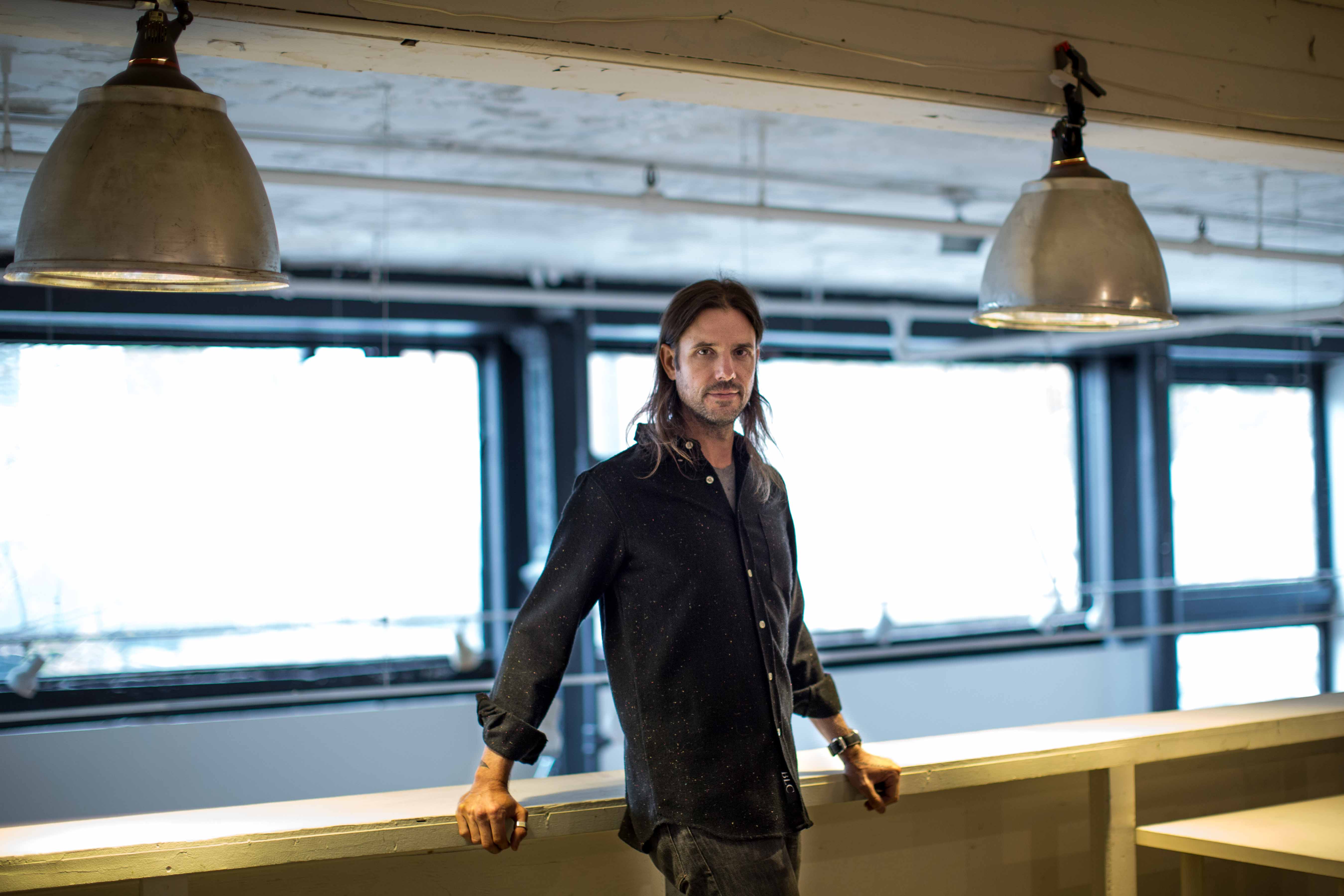
“We have this model. We understand the intricacies of what it takes to get that student’s voice into the courtroom,” Ryan said. “Now we ask that the other stakeholders along that chain realize they have that power and begin to invest specifically and intentionally in helping that young person’s voice make it into the courtroom so these mitigating factors can be heard by judge and positively influence the outcome for that young person.” Ryan estimated that there have been a couple dozen times over 18 years when they’ve been able to noticeably and positively impact a student’s outcome in court. That can mean a host of things, like a diminished sentence, a case thrown out, an alternative to detention or court-ordered care, resulting in hundreds of years shaved off of sentences for Free Write students.
Combined, the portfolio and asset map resonate with another practice for assessing a young person that already exists in the courtroom: mitigation packets. Mitigating factors are those aspects of an individual’s life beyond the alleged crime that could influence a judge to reduce the severity of their sentence. Mitigation packets include materials like letters from teachers, family, and community members, participation in programs, and school records. They are typically compiled by mitigation specialists who are hired by a defendant’s attorney at a high cost. Mathilda, who previously worked with a mitigation firm in Evanston in order to better understand the process, has been developing Free Write’s mitigation packet strategy in conversation with alumni Walter McDavid.
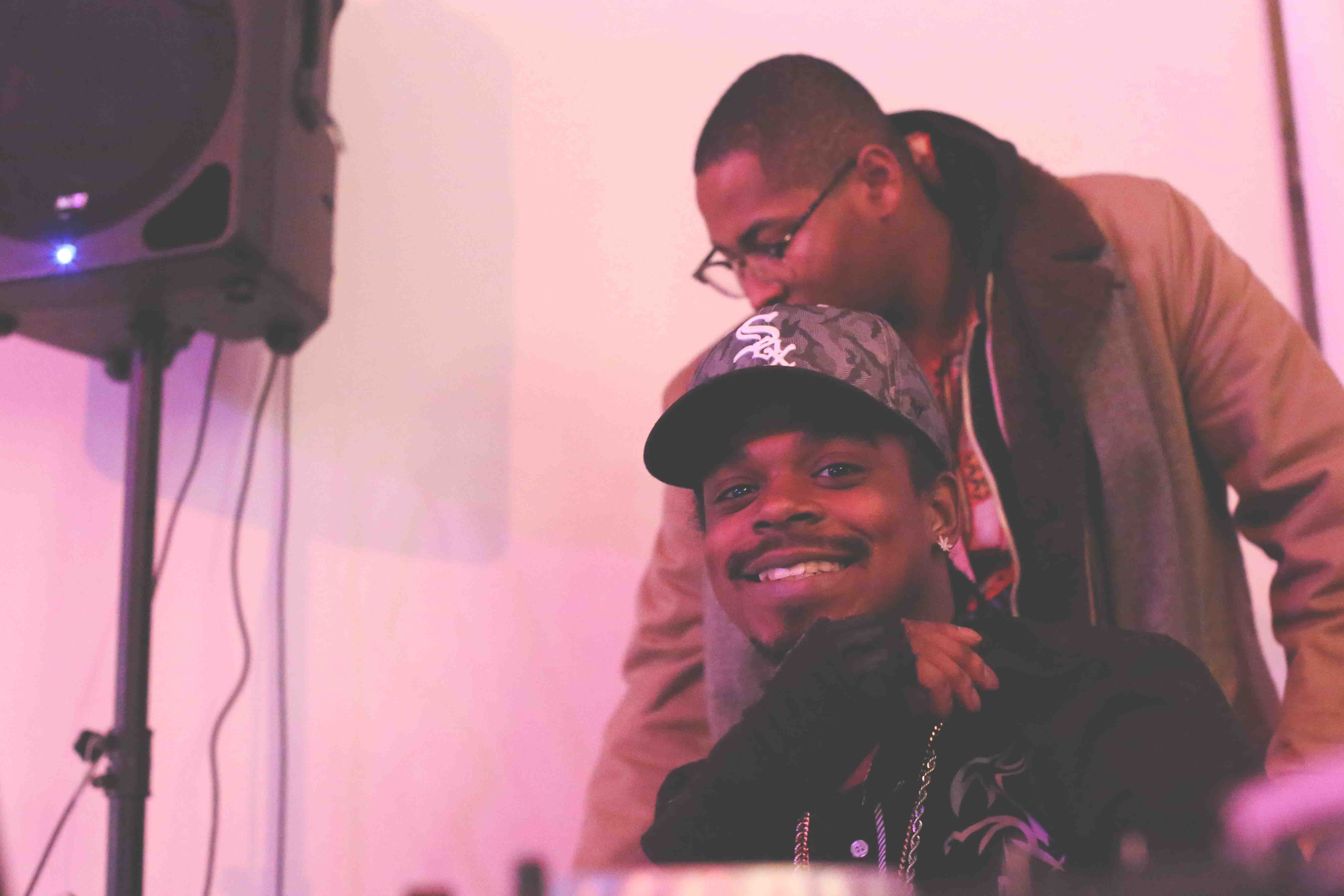
Walter McDavid is 23 years old and has been DJing since he was 12 years old. While in Free Write, he started writing a mythical sci-fi book about dragons that he hopes to finish by his birthday in July. He loves to draw, and he learned the techniques of digital illustration in the Free Write classroom. But he doesn’t like having to add color. “I can give it its general form, but the actual color and feel of it should be up to whoever’s looking at it. And when you actually look at something, it’s a product of imagination. So why should only my imagination be implemented into this artwork? If I leave it in black-and-white, then I give it its structure, but you give it its feeling.”
After coming home, Walter, who was born and raised in Englewood, got in touch with Free Write program director Elgin-Bokari T. Smith to ask for the artwork he made during his time in the Free Write classroom at CCJTDC. Elgin invited him to DJ at Free Write’s open mic event, Stomping Grounds, along with Cortez. Now Walter is also a lead technician with Free Write Sound & Vision, in addition to working with Mathilda to develop mitigation strategies. Walter and I met up in December at Chicago Art Department in Pilsen, where Free Write is a resident organization.
Sasha Tycko: Can you talk about the mitigation process and how what you’re working on with Free Write relates to it?
Walter McDavid: It’s basically trying to give our students that are with Free Write the best possible file, profile, for them to either take to their judge, or just to have—for them to even possibly have a better outlook. Because, as a youth, yeah, you’re going to make tons of mistakes, but you still have time to progress and make it better. And you also have a lot of good things. They not going to go into the courtroom and just tell all the good stuff about you, so you have to do that on your own. So that’s what we’re trying to come up with, how to file [the good stuff]. And actually compile those files and documents. It’s a lot more complicated than I thought.
ST: What are some of the complications that you’re dealing with now?
WM: Actually getting those things on paper. Because, although people writing letters and stuff for you is a good way [to build the file], actually getting people to write those letters is really hard—as well as just trying to get the judge to actually pay attention to it. It’s not just a file of papers. It has its purpose and meaning. So just giving it enough meaning and purpose to actually hold that standing that it should [is difficult].
ST: What has to happen for the judge to take something like that into consideration and for it to have a real impact on a young person?
WM: I mean, the young person has to believe in it and take that stand to say, “Hey, I have this and this is important.” If the person it’s about doesn’t feel it’s important, why should anyone else? So I think that’s a major key in it.
ST: Do you mind sharing your own experience with mitigation, since you said you went through the whole process yourself?
WM: Well, I ended up getting some mitigation specialists when I was going through my case. And for the first, like, two months, they would come every week, twice a week, and I would just sit there and look at them. Because, one, I didn’t understand what a mitigation specialist was, and, like, I just didn’t see its purpose or its standing. I didn’t understand why they were just coming out to sit with me. I didn’t get it. But I did some research and I started to understand, like, “Okay. Y’all trying to help me. Let me help you help me.”
So, I went through the process of just compiling my family tree, my past, basically. I didn’t have any record, so they didn’t have any files at all on me. So it was just a lot of sitting and talking for a good, like, year and a half, twice a week, every week. It was extensive, but in the end the books were huge with my information. I didn’t understand at first how much I had done, since I was still young. But it was cool and it actually did have a major impact on how everything ended up going. If not, I don’t think I’d be sitting here. I think I’d still be downstate [in prison]. So I’m thankful, I’m glad I actually went through and figured that out.
ST: What was included in your mitigation packet?
WM: Letters from my teachers, my mother’s colleagues and stuff, people I had been around, church family, regular family, grades, programs and stuff that I’m included in, sports programs. Just any and every possible positive aspect of my life that had come across in our conversations when we were going back and forth was compiled into this folder. And it was just a lot more than I thought.
ST: You said that you didn’t really understand what the point was at first, and then there was a shift when you started to do research and become more actively involved in the conversations. Do you think that because you did that research on your own, that’s why it was successful? I guess what I’m asking is, if you hadn’t, would it not have been as successful?
WM: I mean, the one thing that hurts people the most is courtroom lingo. If you don’t understand what they’re saying, you just don’t know. When they were saying “mitigation specialist,” I’m like, “What does that even mean? What are you? Why do you keep coming [and] trying to talk to me?” Then I started to look it up and ask questions, and it came around that, oh, just, “We’re trying to help you take as much time off as possible. We’re trying to give you the best look possible to the judge.”
ST: So what impact did it have?
WM: I was looking at 21 to 45 [years]. I actually only spent altogether five years. So, I’m glad. I’m really happy that I didn’t have to do the numbers that I was actually looking at.
* * *
I asked Cortez if his participation in Free Write helped his case. Not while he was in detention, he told me.
“But as far as on the outside, since I’ve been home,” Cortez continued. “Free Write helped me a lot. My probation officer said, like, I might get off probation in February. I had plead guilty because I didn’t want them to send me back to [adult] county court, because there was a possibility that the State’s Attorney could have asked my judge to get me transferred back to the county courts. So before they could [do] any of that, I plead guilty so I could stay in juvenile court. They gave me five years probation, but I only have to do two-and-a-half. But now I’m finna do half of that two-and-a-half, mainly because of Free Write.
“I made an appeal, I gave them check stubs from [Free Write Sound & Vision]. Got the plane tickets from Free Write, to show that Free Write was taking me out of state to teach and speak at conferences. [The probation officer] got the California plane tickets. I was teaching kids how to DJ; that’s in my profile. So basically anything I’ve been doing with Free Write, she been putting in my profile. My judge loved it. So like I said, I was supposed to do two-and-a-half out of that five, but I might end up doing half of that two-and-a-half. So, I mean, Free Write, they helped me. I’ve been working with them since I’ve been home. I’ve had a steady job since I’ve been home. So [the courts are] pretty much looking at me like, ‘Okay, he’s growing up.’… So yeah, they helped me. Not when I was locked up. When you locked up, all they see is them chains on you.”
* * *
I’ve come to understand that this question (how do you envision justice?) is a misdirection, merely an opening for talking about what art enables. Art involves much more than imagination—that popular link between art and politics. Art encompasses a set of strategies, ways of relating to others, forms of knowledge, a means for community, an industry, and, yes, imagination, a gift for seeing the potential other way. Ultimately, the Envisioning Justice residency became, for me, about the unique strategies that art and artists employ, and how these can address (and end) mass incarceration. Free Write is one of the most compelling arguments I’ve encountered for what art is for and what justice is.
* * *
Sasha Tycko: How do you envision justice?
Walter McDavid: I don’t know. Because I can’t really envision justice. Because although I may see something as justice or being right, looking at it from someone else’s perspective, they may be right and justified as well. So I don’t really have that outlook. I don’t have that vision. I like to allow everything to be as it is because it’s not like you can actually control nature. Kind of hippie ain’t it?
ST: If you say so.
WM: I’ll say so.
ST: That’s very open-minded. Would you ask other people to also be that open-minded?
WM: No, because I know how hard it is. I know how hard it is to be open-minded, and yet it has been my most effective way of making it through everything. Because, although I may see something as wrong, yeah, I can speak on it, but just because I see it as wrong doesn’t mean that I’m right. There’s a lot of different ways that things could go. It’s not always black and white as to right and wrong. There can be a lot of different shades and variations to it. You just gotta figure it out.
ST: How would you sum up the impact that Free Write has had on your life?
WM: Free Write has given me my love back. Because, I mean, after I came home I didn’t have any of my DJ equipment. I didn’t have any of the things I wanted to do anymore. So after getting back into it with Free Write, they gave me a DJ controller, a laptop, stuff to work on. And, like, they just gave me everything I love back. So the music, the feel of the crowd, that freedom again.
* * *
ST: How would you sum up the impact Free Write has had on your life?
Cortez Williams: Free Write just been supporting me since I been home, period. I had never been to college, I had went to try but then I ran into some trouble with my financial aid. They didn’t want to give me all the money for my books. So I told Ryan, and Ryan bought them for me. So Free Write pretty much just been supporting, like family. If I need someone to talk to I can call Free Write, talk to Free Write. They pay me well, it’s pretty much like family support. That’s really what somebody needs. Support. Someone they can come to. They support you on the art side, they support you on the school side, I mean, they offer to pay your phone bill, make sure you’re safe. Ain’t no better than that. They care for real. You just need more organizations that care for real.
This article is published as part of Envisioning Justice, a 19-month initiative presented by Illinois Humanities that looks into how Chicagoans and Chicago artists respond to the impact of incarceration in local communities and how the arts and humanities are used to devise strategies for lessening this impact.
Featured image: Elgin-Bokari Smith, a program director and teaching artist with Free Write Arts & Literacy holds a microphone up to his mouth in a circle of young people in attendance at January’s Stomping Grounds, the regular open mic event produced by Free Write. Photo by Chelsea Ross.

 Starting from the proposition that art-making is world-making, Sasha Tycko combines community organizing and curatorial work with writing, music, and performance. Tycko is a founding editor of The Sick Muse zine and an administrator of the F12 Network, a DIY collective that addresses sexual violence in arts communities. IG: @t_cko. www.sashatycko.net. Photo by ColectivoMultipolar.
Starting from the proposition that art-making is world-making, Sasha Tycko combines community organizing and curatorial work with writing, music, and performance. Tycko is a founding editor of The Sick Muse zine and an administrator of the F12 Network, a DIY collective that addresses sexual violence in arts communities. IG: @t_cko. www.sashatycko.net. Photo by ColectivoMultipolar.

